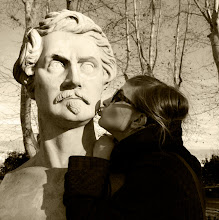
I run from him who hunts me,
the hunted from the hunter,
his hounding presence haunts me,
and allows but bitter rest.
Mind reeling, scratching, scrambling,
screeching, sinking, plunging
clawing, tearing, spiraling
spiraling wildly down.
Fingers raking for an anchor.
Clutching, clutching for an answer.
Grasping, grasping but there is nothing -
but there is nothing there.
He ripped them from their roots, he did!
From their very roots, he did!
A thousand empty sockets,
stare out from empty field,
look out to empty sockets,
reach in to emptiness.
And now I've found some stillness,
within this mad-house world,
within this weeping world.
In this shattered haven,
this crumbling shattered haven,
this tattered matted haven,
I've found my happiness.
My thoughts wheel 'round the ruins,
around the crumbled ruins
there's solace in the shadows...
... and safety with the Beast.










-ori.jpg)



